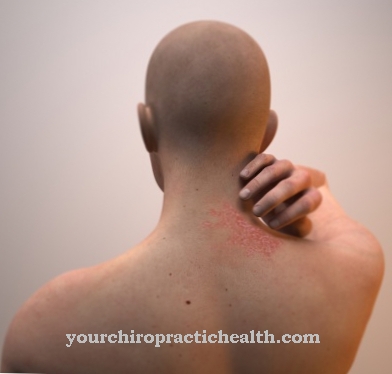Pain are mild to severe, unpleasant complaints that can affect the whole body. They are pounding, tearing, flowing, stabbing or causing other feelings that clearly indicate that something is wrong with your own body.
What is pain

Pain is an uncomfortable feeling that can appear anywhere in the body. There is mild pain that can be endured without any problems, but also severe pain that you can hardly imagine if you have never had it.
Pain always indicates that there is an injury or disease in the body that attacks the tissue and thus causes the discomfort. In principle, pain can occur throughout the body and in all types of tissue, i.e. in bones, connective tissue or soft tissues.
Forms of pain:
- Burning pain
- Chest pain
- Joint pain
- Body aches
- Sore throat
- a headache
- stomach pain
- Muscle aches
- Earache
- Back pain
- Shoulder pain
- Sharp pain
- Abdominal pain
- Toothache
causes
Pain occurs due to irritation of the nerves. If there is an injury, for example a cut on the skin, the nerves in the corresponding area are also affected and react by releasing painful stimuli.
Pain in the bones has a similar cause and occurs, for example, with fractures, but also with contact with pathogens. Pain in the internal organs is mostly due to a disease that attacks the tissue, such as inflammation.
Some pain, such as a headache, is caused by stress. The muscles tense up and ensure that the nerves are squeezed or come into contact with pain-triggering messenger substances.
So some pains also have a purely neurological cause and are triggered by a malfunction or an improper stress on the body in everyday life.
You can find your medication here
➔ Medicines for painDiseases with this symptom
- Hypothermia
- Heart attack
- combustion
- migraine
- Cystitis
- stroke
- Broken rib
- Myocarditis
- Lung cancer
- Mediastinitis
- pleurisy
- arthrosis
- rheumatism
- gout
- Obesity
- hepatitis
- Lyme disease
- Meniscal tear
course
Most mild pain will go away on its own. They only occur with harmless injuries or with headaches that are simply tension-related.
Moderate pain, on the other hand, can go away on its own, but it takes longer because more nerves are usually involved in the pain.
Severe pain, on the other hand, seldom lasts long, is so unbearable for the patient that it is treated when it occurs. Regardless of the severity of the pain, it can occur again and again - this is common with contact with pain-causing pathogens or underlying diseases that are in the healing phase.
People who have severe pain as a result of cancer, in turn, often suffer from permanent pain that does not go away on its own, but needs urgent treatment.
Complications
Various complications can arise with pain. Generally speaking, the lack of symptomatic treatment for pain can lead to it becoming chronic. In retrospect, it is often no longer possible to identify a physical cause for the persistent malaise. The pain persists as a symptom even after the disease has long healed.
The reason for this is physical memory. On the other hand, constantly recurring pain can attack the psyche of the person concerned. Painkillers, which can damage the body in the long term, are taken for fear of the pain occurring again. On the other hand, those who do not take medication to relieve severe pain often unconsciously fall into a relieving position.
Such a bad posture can on the one hand lead to a shift in pain and on the other hand damage unaffected areas of the body. Subsequent pain in the spine area caused by a relieving posture that has been maintained for too long is particularly common. Chronic pain patients are often difficult to treat. In some cases the abnormal sensations can no longer be completely combated and can only be reduced to a lesser extent.
This leads to increased frustration and conflicts with the treating physician. On top of that, another complication is that non-treatment can lead to aggression and depression in the patient in the long term. This lowers the pain threshold and the patient finds himself in a vicious circle.
When should you go to the doctor?
In the case of pain, it is not possible to make a general prediction whether it will need to be examined by a doctor or not. As a rule, pain indicates to those affected by a signal that something is wrong in the body. This can only be a slight bruise or overexertion or a serious illness. In general, the patient should always be able to live without pain, and pain at rest should not occur either.
If the pain occurs over a longer period of time and does not go away on its own, a doctor should be consulted. Treatment and its success depend heavily on the cause of the pain and the underlying disease. Especially if the pain becomes unbearable, an emergency doctor or hospital must be visited. The patient should never treat pain with pain medication alone for long periods of time.
If the pain occurs after an accident, a doctor must also be consulted. In the case of general pain that cannot be assigned to a specific illness, a visit to the family doctor or the hospital is suitable if the pain is unbearable. In certain regions, such as toothache, the respective doctor can be visited directly.
Doctors & therapists in your area
Treatment & Therapy

When treating pain, a distinction is made between curative and palliative treatment. The curative treatment aims to combat the pain along with its cause. Usually, means are used that eliminate the pain so that the patient is well during the treatment of his underlying disease.
Some of these remedies (pain relievers) are also freely available and are used, for example, for headaches that have no more serious cause than the stress of everyday life. The curative treatment also includes strong pain relievers, which are intended to immediately eliminate severe pain.
Palliative pain treatment, on the other hand, is aimed at patients who will die from their underlying disease or who cannot be cured, even if the disease itself does not lead to death. Many cancer patients receive palliative treatment in the last weeks and months of their lives because they would be in severe pain if they were not given medication. Diseases like fibromyalgia, on the other hand, are uncomfortable but not fatal, so they cannot be treated curatively. However, the aim is not to leave the patient alone with their pain.
Pain relief agents are usually administered in the form of tablets, as the common agents are also suitable in high doses. Syringes and infusions are also possible.
Outlook & forecast
A general prognosis cannot be made for pain. Whether treatment is possible or necessary depends very much on the pain itself and must be decided in each individual case. However, in medicine, pain can almost always be numbed or limited. This means that patients do not feel any pain during treatments or operations.
Painkillers can be used for minor or short-term pain. It is important to ensure that these are not consumed in excess, as they are harmful to the stomach. In the case of persistent and unbearable pain, however, a doctor should always be consulted, as this pain is a major complication.
Most of the time, the causes of the pain can be found relatively easily and combated. Pain can be treated either with medication or surgically.
It is not uncommon for pain to spread to different regions. Toothache, for example, can also lead to headaches and stress other regions of the body. In such cases, a doctor can provide information about the cause of the pain and treat it.
You can find your medication here
➔ Medicines for painprevention
Home remedies ↵ for pain You can prevent pain by protecting yourself as much as possible from it in everyday life. Care should be taken when handling objects or situations in which one could injure oneself and wear protective clothing when offered. Even in sport, caution is the top priority for yourself and others.
However, it is difficult to prevent pain caused by illness. It is important to prevent a wide variety of diseases here.
You can do that yourself
Pain sufferers should keep moving whenever they can. Just a short walk can distract you from thinking about the pain. It is important not to overwhelm yourself and rather to start with shorter distances. When walking, the muscles are also loosened and the joints moved. Nordic walking or other sports can also distract from pain. The GP can assess what kind of exercise is useful for pain sufferers.
In addition, those affected should ensure small moments of happiness in everyday life. Even small things can help to regain a bit of zest for life, especially with chronic pain. They give inner satisfaction and alleviate moments of pain. Relaxation procedures loosen tense muscles and improve body awareness. Stress-related bad posture and tension are noticed early and stress is reduced in a targeted manner. In pain therapy, for example, autogenic training and progressive muscle relaxation according to Jacobson are useful. Heat often helps relieve pain. A hot water bottle or a warm pack can be placed on the affected areas.
It is important not to ignore pain. Pain sufferers should go to the doctor in good time and speak openly about the pain. The earlier the pain is treated, the greater the chances of recovery. The help of an expert should be accepted not only with physical, but also with psychological pain.




.jpg)
.jpg)





















